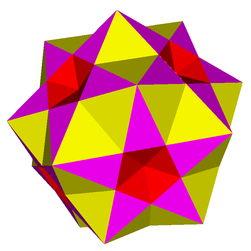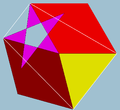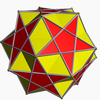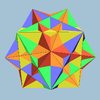- Small complex rhombicosidodecahedron
-
Small complex rhombicosidodecahedron 
Type Uniform star polyhedron Elements F = 62, E = 120 (60x2)
V = 20 (χ = -38)Faces by sides 20{3}+12{5/2}+30{4} Wythoff symbol 5/2 3 | 2 Symmetry group Ih, [5,3], *532 Index references U-, C-, W- 
(3.4.5/2.4)3
(Vertex figure)120px
Small complex rhombicosidodecacron
(dual polyhedron)In geometry, the small complex rhombicosidodecahedron (also known as the small complex ditrigonal rhombicosidodecahedron) is a degenerate uniform star polyhedron. It has 62 faces (20 triangles, 12 pentagrams and 30 squares), 120 (doubled) edges and 20 vertices. All edges are doubled (making it degenerate), sharing 4 faces, but are considered as two overlapping edges as a topological polyhedron.
It can be constructed from the vertex figure (5/2.4.3.4)3, thus making it look identical to the cantellated great icosahedron.
Contents
As a compound
It can be seen as a compound of the small ditrigonal icosidodecahedron, U30, and the compound of five cubes. It is also a facetting of the dodecahedron.
Compound polyhedron 


Small ditrigonal icosidodecahedron Compound of five cubes Compound As a cantellation
It can also be seen as a cantellation of the great icosahedron (or, equivalently, of the great stellated dodecahedron).
(p q 2) Fund.
triangleParent Truncated Rectified Bitruncated Birectified
(dual)Cantellated Omnitruncated
(Cantitruncated)Snub Wythoff symbol q | p 2 2 q | p 2 | p q 2 p | q p | q 2 p q | 2 p q 2 | | p q 2 Schläfli symbol t0{p,q} t0,1{p,q} t1{p,q} t1,2{p,q} t2{p,q} t0,2{p,q} t0,1,2{p,q} s{p,q} Coxeter–Dynkin diagram 







































Vertex figure pq (q.2p.2p) (p.q.p.q) (p. 2q.2q) qp (p. 4.q.4) (4.2p.2q) (3.3.p. 3.q) Icosahedral
(5/2 3 2)
{3,5/2}
(5/2.6.6)
(3.5/2)2
[3.10/2.10/2]
{5/2,3}
[3.4.5/2.4]
[4.10/2.6]
(3.3.3.3.5/2)Related degenerate uniform polyhedra
Two other degenerate uniform polyhedra are also facettings of the dodecahedron. They are the complex rhombidodecadodecahedron (a compound of the ditrigonal dodecadodecahedron and the compound of five cubes) with vertex figure (5/3.4.5.4)/3 and the great complex rhombicosidodecahedron (a compound of the great ditrigonal icosidodecahedron and the compound of five cubes) with vertex figure (5/4.4.3/2.4)/3. All three degenerate uniform polyhedra have each vertex really being three coincident vertices and each edge really being two coincident edges.
They can all be constructed by cantellating regular polyhedra.
See also
- Small complex icosidodecahedron
- Great complex icosidodecahedron
- Complex rhombidodecadodecahedron
- Great complex rhombicosidodecahedron
References
- Richard Klitzing, 3D uniform polyhedra, sicdatrid
- Richard Klitzing, 3D uniform polyhedra, cadditradid
- Richard Klitzing, 3D uniform polyhedra, gicdatrid

This geometry-related article is a stub. You can help Wikipedia by expanding it.
